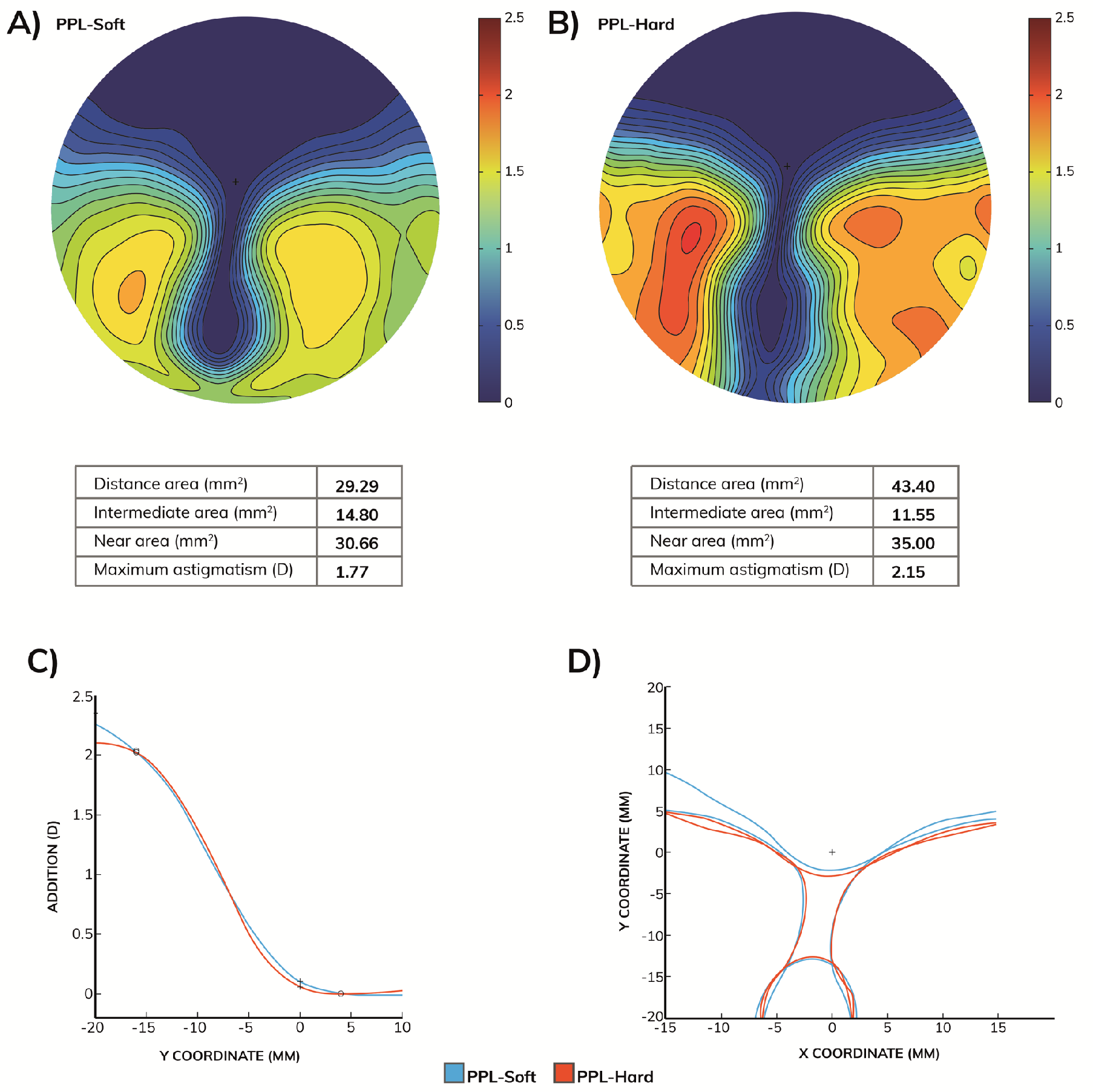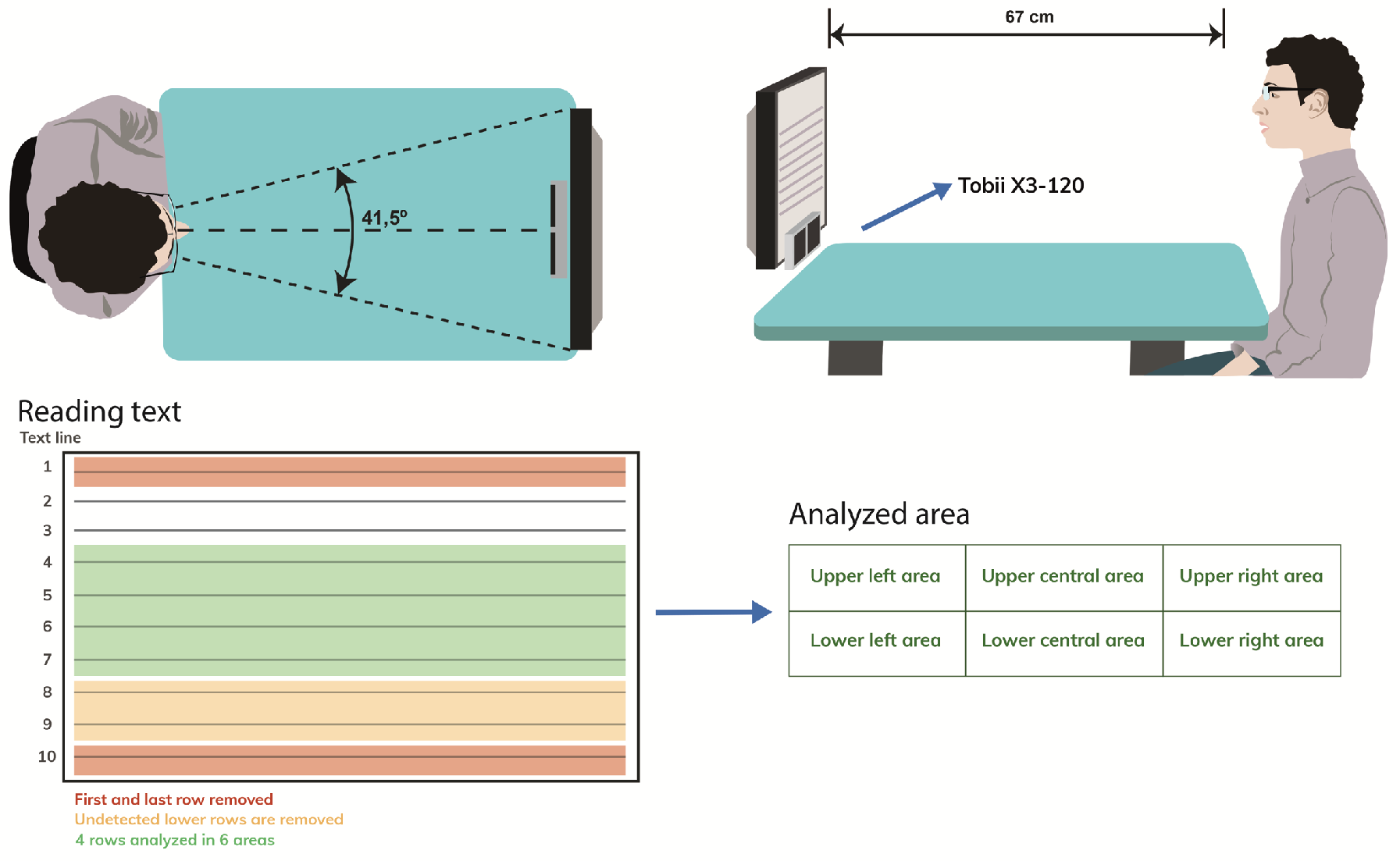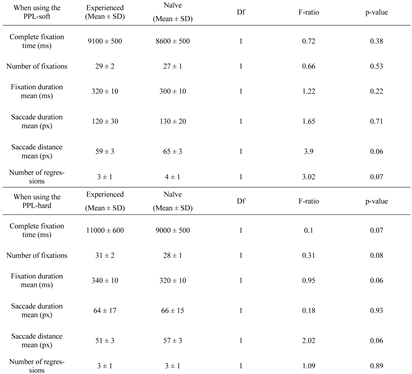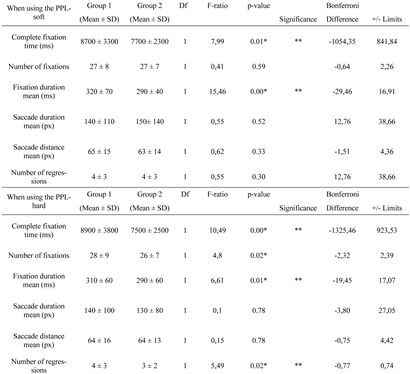Eye Movements as a Predictor of Preference for Progressive Power Lenses
Abstract
Introduction
Methods
Design
Participants
Procedure
Materials
Progressive Power Lenses
Eye-tracking recording
Reading text
Subjective Evaluation
Statistical Analysis
Results
Sample characteristics
EM behavior depending on user PPL previous experience
EM behavior depending on user PPL preference
Discussion
Ethics and Conflict of Interest
Acknowledgements
References
- Alonso, J., J. A. Gómez-Pedrero, and J. A. Quiroga. 2019. Modern ophthalmic optics. Cambridge University Press. [Google Scholar]
- Alvarez, T. L., S. Han, C. Kania, E. Kim, O. Tsang, J. L. Semmlow, B. Granger-Donetti, and C. Pedrono. 2009. Adaptation to progressive lenses by presbyopes. 2009 4th International IEEE/EMBS Conference on Neural Engineering; pp. 143–146. [Google Scholar]
- Alvarez, T. L., E. H. Kim, and B. Granger-Donetti. 2017. Adaptation to progressive additive lenses: potential factors to consider. Scientific Reports 7, 1: 1–14. [Google Scholar] [CrossRef] [PubMed]
- Arroyo, R., D. Crespo, and J. Alonso. 2012. Scoring of Progressive Power Lenses by Means of User Power Maps. www.optvissci.com.
- Arroyo, R., D. Crespo, and J. Alonso. 2013. Influence of the Base Curve in the Performance of Customized and Classical Progressive Lenses. In Optometry and Vision Science. Vol. 90, Issue 3, www.optvissci.com.
- Chamorro, E. 2018. Lens Design Techniques to Improve Satisfaction in Free-Form Progressive Addition Lens Users. JOJ Ophthalmology 6, 3. [Google Scholar] [CrossRef]
- Chamorro, E., J. M. Cleva, M. Alvarez, M. S. Subero, and M. Garcia. 2019. MESOPIC VISUAL FUNCTION ATTAINED BY LENSES SPECIFICALLY DESIGNED FOR MESOPIC VISION. Investigative Ophthalmology & Visual Science 60, 9: 5935. [Google Scholar]
- Concepción, P., A. González, E. Chamorro, J. M. Cleva, and J. Alonso. 2019. Eye movements during reading on a computer screen with progressive power lenses. In European Conference on Eye Movements. European Conference on Eye Movements. [Google Scholar]
- Concepción, P., A. Gonzalez, E. Chamorro, J. M. Cleva Millor, and J. Alonso. 2018. Evaluación de las diferencias en prestaciones entre diferentes lentes progresivas durante la lectura en ordenador mediante el uso de tecnología eye-tracking.
- Duchowski, A. T., and A. T. Duchowski. 2017. Eye tracking methodology: Theory and practice. Springer. [Google Scholar]
- Fehringer, B. C. O. F. 2021. Optimizing the usage of pupillary based indicators for cognitive workload. Journal of Eye Movement Research 14, 2: 1–12. [Google Scholar] [CrossRef]
- Feis, A., A. Lallensack, E. Pallante, M. Nielsen, N. Demarco, and B. Vasudevan. 2021. Reading Eye Movements Performance on iPad vs. Print Using a Visagraph. Journal of Eye Movement Research 14, 2: 1–8. [Google Scholar] [CrossRef]
- Grüner, M., and U. Ansorge. 2017. Mobile eye tracking during real-world night driving: A selective review of findings and recommendations for future research. Journal of Eye Movement Research 10, 2. [Google Scholar] [CrossRef] [PubMed]
- Günther, F., H. J. Müller, J. Kacian, H. R. Liesefeld, and S. Pierides. 2020. Reading english-language haiku: An eye-movement study of the “cut effect”. Journal of Eye Movement Research 13, 2. [Google Scholar] [CrossRef]
- Habtegiorgis, S. W., K. Rifai, M. Lappe, and S. Wahl. 2018. Experience-dependent long-term facilitation of skew adaptation. Journal of Vision 18, 9: 1–11. [Google Scholar] [CrossRef]
- Han, S. C., A. D. Graham, and M. C. Lin. 2011. Clinical Assessment of a Customized Free-Form Progressive Add Lens Spectacle. www.clinicaltrials.gov.
- Han, Y., K. J. Ciuffreda, A. Selenow, and S. R. Ali. 2003. Dynamic Interactions of Eye and Head Movements When Reading with Single-Vision and Progressive Lenses in a Simulated Computer-Based Environment. Investigative Ophthalmology & Visual Science 44, 4: 1534–1545. [Google Scholar] [CrossRef]
- Han, Y., K. J. Ciuffreda, A. Selenow, E. Bauer, S. R. Ali, and W. Spencer. 2003. Static Aspects of Eye and Head Movements during Reading in a Simulated Computer-Based Environment with SingleVision and Progressive Lenses. Investigative Ophthalmology & Visual Science 44, 1: 145–153. [Google Scholar] [CrossRef][Green Version]
- Hitzeman, S. A., and C. O. Myers. 1985. Comparison of the acceptance of progressive addition multifocal vs. a standard multifocal lens design. Journal of the American Optometric Association 56, 9: 706–710. [Google Scholar] [PubMed]
- Holm, S. K., K. Olli, T. Häikiö, and J. K. Kaakinen. 2021. Eye Movements during Dynamic Scene Viewing are Affected by Visual Attention Skills and Events of the Scene: Evidence from FirstPerson Shooter Gameplay Videos. Journal of Eye Movement Research 14, 2: 01–31. [Google Scholar] [CrossRef] [PubMed]
- Holmqvist, K., and R. Andersson. 2017. Eye-tracking: A comprehensive guide to methods, paradigms and measures.
- Hyönä, J., A. Pollatsek, M. Koski, and H. Olkoniemi. 2020. An eye-tracking study of reading long and short novel and lexicalized compound words. Journal of Eye Movement Research 13, 4. [Google Scholar] [CrossRef] [PubMed]
- Hutchings, N., E. L. Irving, N. Jung, L. M. Dowling, and K. A. Wells. 2007. Eye and head movement alterations in naïve progressive addition lens wearers. Ophthalmic and Physiological Optics 27, 2: 142–153. [Google Scholar] [CrossRef]
- Ivanchenko, D., K. Rifai, Z. M. Hafed, and F. Schaeffel. 2021. A low-cost, high-performance video-based binocular eye tracker for psychophysical research. Journal of Eye Movement Research 14, 3: 1–21. [Google Scholar] [CrossRef]
- Joss, J., and S. Jainta. 2020. Do standard optometric measures predict binocular coordination during reading? Journal of Eye Movement Research 13, 6: 1–12. [Google Scholar] [CrossRef]
- Kang, S. L., S. B. Beylergil, A. G. Shaikh, J. OteroMillan, and F. F. Ghasia. 2019. Fixational Eye Movement Waveforms in Amblyopia: Characteristics of Fast and Slow Eye Movements. Journal of Eye Movement Research 12, 6: 1–25. [Google Scholar] [CrossRef]
- Limited, S. A., and S. N. Zealand. 2019. Ophthalmic Optics: Uncut finished spectacle lenses. Specifications for power-variation lenses (Issue parte 2). jointly published by SAI Global Limited under license from Standards Australia Limited. https://books.google.es/books?id=QgCszQEACAAJ.
- Mateo, B., R. Porcar-Seder, J. S. Solaz, and J. C. Dürsteler. 2010. Experimental procedure for measuring and comparing head–neck–trunk posture and movements caused by different progressive addition lens designs. Ergonomics 53, 7: 904–913. [Google Scholar] [CrossRef]
- Millodot, M. 2014. Dictionary of Optometry and Visual Science E-Book. Elsevier Health Sciences. [Google Scholar]
- Negi, S., and R. Mitra. 2020. Fixation duration and the learning process: an eye tracking study with subtitled videos. Journal of Eye Movement Research 13, 6: 1–15. [Google Scholar] [CrossRef]
- Raasch, T. W., S. † Lijuan, A. Yi, and * Od. 2011. Whole-Surface Characterization of Progressive Addition Lenses. In Optometry and Vision Science. Vol. 88, Issue 2, www.optvissci.com.
- Rifai, K., and S. Wahl. 2016. Specific eye-head coordination enhances vision in progressive lens wearers. Journal of Vision 16, 11. [Google Scholar] [CrossRef]
- Selenow, A. 2000. Progressive lenses: new techniques for assessing visual performance. Vision Science and Its Applications, MD4. [Google Scholar]
- Selenow, A., E. A. Bauer, S. R. Ali, L. W. Spencer, and K. J. Ciuffreda. 2002. Assessing Visual Performance with Progressive Addition Lenses. In Optometry and Vision Science. Vol. 79, Issue 8. [Google Scholar]
- Sheedy, J. E. 2004a. Progressive addition lenses Matching the specific lens to patient needs. Optometry 75, 2: 83–102. [Google Scholar] [CrossRef] [PubMed]
- Sheedy, J. E. 2004b. Correlation analysis of the optics of progressive addition lenses. Optometry and Vision Science 81, 5: 350–361. [Google Scholar] [CrossRef] [PubMed][Green Version]
- Sheedy, J. E., C. Campbell, E. King-Smith, and J. R. Hayes. 2005. Progressive Powered Lenses: the Minkwitz Theorem.
- Sheedy, J. E., and R. F. Hardy. 2005. The optics of occupational progressive lenses. Optometry-Journal of the American Optometric Association 76, 8: 432–441. [Google Scholar] [CrossRef]
- Spaulding, D. H. 1981. Patient preference for a progressive addition multifocal lens (Varilux2) vs. a standard multifocal lens design (ST-25). Journal of the American Optometric Association 52, 10: 789–794. [Google Scholar]
- Voßkühler, A., V. Nordmeier, L. Kuchinke, and A. M. Jacobs. 2008. OGAMA (Open Gaze and Mouse Analyzer): open-source software designed to analyze eye and mouse movements in slideshow study designs. Behavior Research Methods 40, 4: 1150–1162. [Google Scholar] [CrossRef]


 |
 |
 |
Disclaimer/Publisher’s Note: The statements, opinions and data contained in all publications are solely those of the individual author(s) and contributor(s) and not of MDPI and/or the editor(s). MDPI and/or the editor(s) disclaim responsibility for any injury to people or property resulting from any ideas, methods, instructions or products referred to in the content. |
© 2022 by the authors. Licensee MDPI, Basel, Switzerland. This article is an open access article distributed under the terms and conditions of the Creative Commons Attribution (CC BY) license (https://creativecommons.org/licenses/by/4.0/).
Share and Cite
Concepcion-Grande, P.; González, A.; Chamorro, E.; Miguel Cleva, J.; Alonso, J.; Gómez-Pedrero, J.A. Eye Movements as a Predictor of Preference for Progressive Power Lenses. J. Eye Mov. Res. 2022, 15, 1-12. https://doi.org/10.16910/jemr.15.2.6
Concepcion-Grande P, González A, Chamorro E, Miguel Cleva J, Alonso J, Gómez-Pedrero JA. Eye Movements as a Predictor of Preference for Progressive Power Lenses. Journal of Eye Movement Research. 2022; 15(2):1-12. https://doi.org/10.16910/jemr.15.2.6
Chicago/Turabian StyleConcepcion-Grande, Pablo, Amelia González, Eva Chamorro, José Miguel Cleva, José Alonso, and Jose Antonio Gómez-Pedrero. 2022. "Eye Movements as a Predictor of Preference for Progressive Power Lenses" Journal of Eye Movement Research 15, no. 2: 1-12. https://doi.org/10.16910/jemr.15.2.6
APA StyleConcepcion-Grande, P., González, A., Chamorro, E., Miguel Cleva, J., Alonso, J., & Gómez-Pedrero, J. A. (2022). Eye Movements as a Predictor of Preference for Progressive Power Lenses. Journal of Eye Movement Research, 15(2), 1-12. https://doi.org/10.16910/jemr.15.2.6



